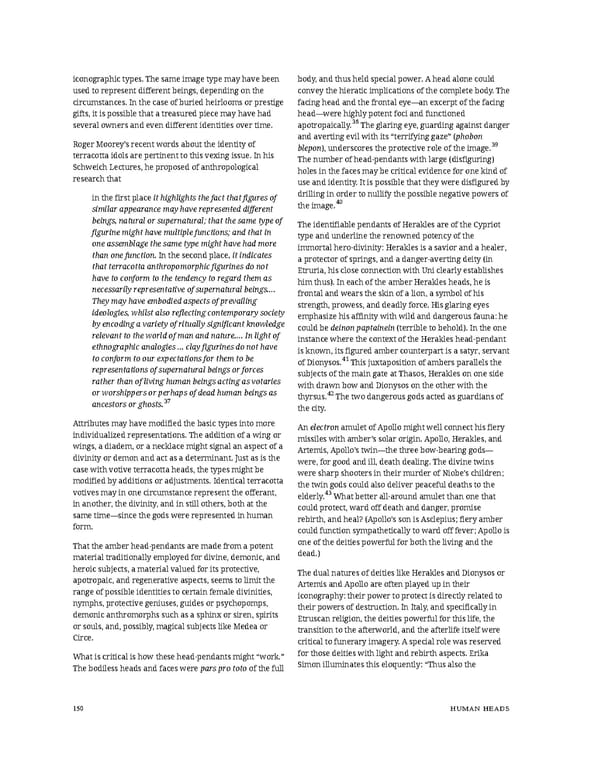iconographic types. The same image type may have been body, and thus held special power. A head alone could used to represent different beings, depending on the convey the hieratic implications of the complete body. The circumstances. In the case of buried heirlooms or prestige facing head and the frontal eye—an excerpt of the facing gifts, it is possible that a treasured piece may have had head—were highly potent foci and functioned several owners and even different identities over time. apotropaically.38 The glaring eye, guarding against danger and averting evil with its “terrifying gaze” (phobon Roger Moorey’s recent words about the identity of blepon), underscores the protective role of the image.39 terracotta idols are pertinent to this vexing issue. In his The number of head-pendants with large (disfiguring) Schweich Lectures, he proposed of anthropological holes in the faces may be critical evidence for one kind of research that use and identity. It is possible that they were disfigured by in the first place it highlights the fact that figures of drilling in order to nullify the possible negative powers of the image.40 similar appearance may have represented different beings, natural or supernatural; that the same type of The identifiable pendants of Herakles are of the Cypriot figurine might have multiple functions; and that in type and underline the renowned potency of the one assemblage the same type might have had more immortal hero-divinity: Herakles is a savior and a healer, than one function. In the second place, it indicates a protector of springs, and a danger-averting deity (in that terracotta anthropomorphic figurines do not Etruria, his close connection with Uni clearly establishes have to conform to the tendency to regard them as him thus). In each of the amber Herakles heads, he is necessarily representative of supernatural beings.… frontal and wears the skin of a lion, a symbol of his They may have embodied aspects of prevailing strength, prowess, and deadly force. His glaring eyes ideologies, whilst also reflecting contemporary society emphasize his affinity with wild and dangerous fauna: he by encoding a variety of ritually significant knowledge could be deinon paptainein (terrible to behold). In the one relevant to the world of man and nature.… In light of instance where the context of the Herakles head-pendant ethnographic analogies … clay figurines do not have is known, its figured amber counterpart is a satyr, servant to conform to our expectations for them to be of Dionysos.41 This juxtaposition of ambers parallels the representations of supernatural beings or forces subjects of the main gate at Thasos, Herakles on one side rather than of living human beings acting as votaries with drawn bow and Dionysos on the other with the or worshippers or perhaps of dead human beings as thyrsus.42 The two dangerous gods acted as guardians of ancestors or ghosts.37 the city. Attributes may have modified the basic types into more Anelectronamulet of Apollo might well connect his fiery individualized representations. The addition of a wing or missiles with amber’s solar origin. Apollo, Herakles, and wings, a diadem, or a necklace might signal an aspect of a Artemis, Apollo’s twin—the three bow-bearing gods— divinity or demon and act as a determinant. Just as is the were, for good and ill, death dealing. The divine twins case with votive terracotta heads, the types might be were sharp shooters in their murder of Niobe’s children; modified by additions or adjustments. Identical terracotta the twin gods could also deliver peaceful deaths to the votives may in one circumstance represent the offerant, elderly.43 What better all-around amulet than one that in another, the divinity, and in still others, both at the could protect, ward off death and danger, promise same time—since the gods were represented in human rebirth, and heal? (Apollo’s son is Asclepius; fiery amber form. could function sympathetically to ward off fever; Apollo is That the amber head-pendants are made from a potent one of the deities powerful for both the living and the material traditionally employed for divine, demonic, and dead.) heroic subjects, a material valued for its protective, The dual natures of deities like Herakles and Dionysos or apotropaic, and regenerative aspects, seems to limit the Artemis and Apollo are often played up in their range of possible identities to certain female divinities, iconography: their power to protect is directly related to nymphs, protective geniuses, guides or psychopomps, their powers of destruction. In Italy, and specifically in demonic anthromorphs such as a sphinx or siren, spirits Etruscan religion, the deities powerful for this life, the or souls, and, possibly, magical subjects like Medea or transition to the afterworld, and the afterlife itself were Circe. critical to funerary imagery. A special role was reserved What is critical is how these head-pendants might “work.” for those deities with light and rebirth aspects. Erika The bodiless heads and faces were pars pro toto of the full Simon illuminates this eloquently: “Thus also the 150 HUMAN HEADS
 Ancient Carved Ambers in the J. Paul Getty Museum Page 159 Page 161
Ancient Carved Ambers in the J. Paul Getty Museum Page 159 Page 161